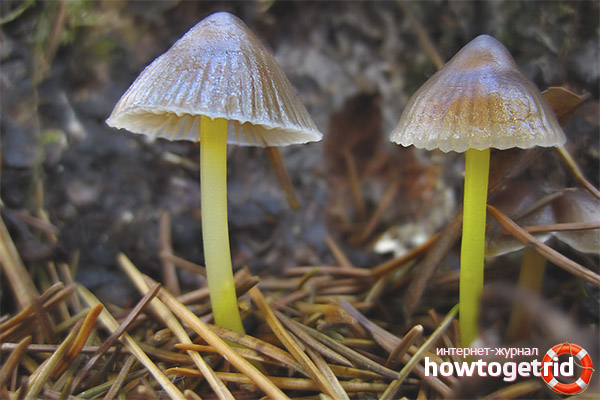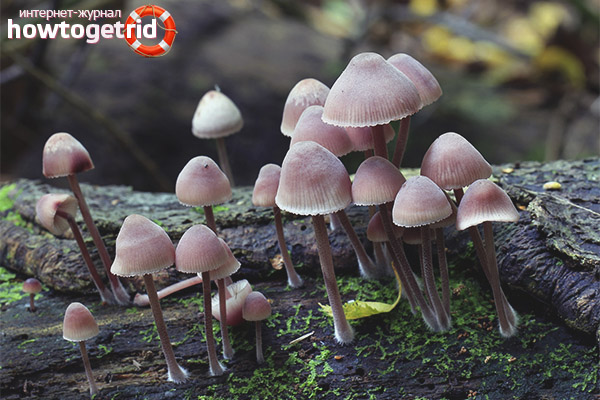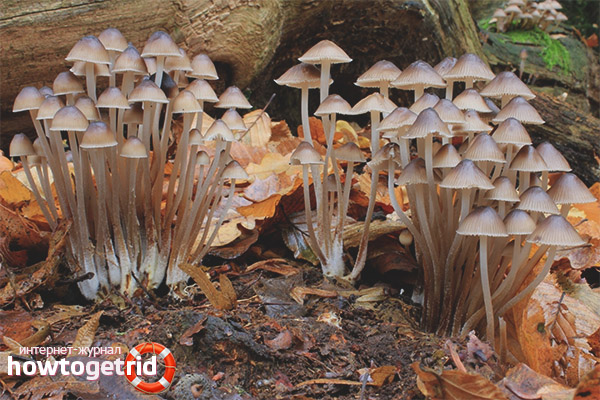The content of the article
One of the varieties of hallucinogenic fungi is mycene. This fruiting body cannot be eaten due to toxicity. It is important to be able to distinguish this species from self-similar so as not to accidentally collect it together with edible specimens.
Varieties of mycenae
If we consider these varieties from the side of the possibility or impossibility of consumption in food, then it is necessary to lean towards the second option. All mycenae are not interesting from the gastronomic point of view. Some of them are poisonous, while others are classified as conditionally edible. But in practice, all fruiting bodies should be avoided. Therefore, experts also persuade lovers of quiet hunting to give preference to exclusively edible species, and to ignore hallucinogens.
But the scientific community is interested in three varieties of this family, including a pink, clean and sticky mycene. Let's analyze their characteristics step by step.
Clean
- The fruit body is unique in its own way. Distributed in various parts of the globe. If you start from the opinions of mycologists, fruiting bodies can be found in Africa and Greenland without any problems.
- Initially, this variety was considered edible. However, over time, cases of poisoning began to occur more often. Therefore, the fungus was transferred to the category of poisonous. The composition contains psychotropic substances that, after ingestion, cause hallucinations. In addition to the postscript, the “poisonous” mycene received the second name “hallucinogenic”.
- Recognizing fruiting bodies is easy enough. The hat is bell-shaped in the format, over the course of the life cycle it begins to bulge and gains volume. It grows up to 2–4 cm in diameter. Notches are present along the edges. There is no single shade of top, the palette is impressive. This mycene may be bluish, lilac, pinkish or gray.
- The plates are not too close to each other. They are painted in purple or match the shade of a hat. When the flesh goes to break, then this place is pigmented with a violet-blue tint. As for the taste, they are somewhat reminiscent of a radish. However, it is worth remembering the ban on the intake of these mushrooms.
- The base is thin, smooth, in the format of a cylinder. The inside is empty. The leg is painted in the color of the top. Considering the fruiting season, we can say that it occurs at the beginning of summer and continues until the beginning of autumn. Mushrooms live on fallen leaves or conifers.
Sticky
- Otherwise, this species is called sticky. Initially, the top has a bell-shaped format. But with the course of life it becomes widespread and increases in diameter. In the middle there may be a small tubercle, and stripes are located next to it. Notches are present at the edges. It will be possible to recognize this fruiting body by certain criteria.
- The top reaches 3 cm in width. It is smoothed, with gloss, and has a sticky layer. On contact it adheres to the skin. Hence the mushroom and got its name. Young growth is pigmented brown-gray on top. Adult fruiting bodies turn yellow with red dots. The plates are narrow, can stick together.
- Rounded format base, rigid, high. It grows to 6 cm. With a diameter of 3 mm. The leg is smoothed, at first there may be fluff. The color matches the top or so. If you click on the base, it will turn red. In a normal situation, it turns yellow.
- The soft part is practically absent. She is refined and gray, smells of rot. Growth is carried out in the coniferous strip, these fruiting bodies like eating. Develop near hemp and roots.Need a bed of needles or foliage. It will be possible to find instances starting from the end of spring, ending with the beginning of autumn.
- These fruiting bodies attract the attention of a person with an exquisite pinkish shade, with which the top is pigmented. During the life cycle, this color does not become so bright, it fades and soon a gray pigment forms. The hats are initially pink, clearly visible against the background of soil and foliage, so people and predators do not pass by.
- Growth is carried out exclusively in those places where there is fallen old foliage. Often this mushroom is located in larch and coniferous strip. The basis of the fruiting body is a toxic substance called muscarine.
- Eating this fruiting body is strictly prohibited. It will be possible to recognize it by the bright pink color of the hat in young animals or in grayness in mature specimens. Distribution is carried out colonially or singly.
- For development, these specimens choose a place where there is a beech or oak. The soft part is odorless, stained with white pigment. The hat is smooth, no bulges or incisors. The diameter of the tip never grows more than 3 cm. The edges are tucked both inward and outward. In the center there may be a tubercle.
- The plates are pigmented in pastel colors, they are large. The base is smooth, empty, pigmented in light gray or pure white. Representatives of the genus grow in the southern region, fruiting begins in late spring and ends in mid-late autumn.
Virulence
- Fruit bodies concentrate poison, which when it enters the human body affects the hearing and vision. Hallucinations associated with these internal organs appear. A person’s perception of reality changes, colors become brighter, and sound becomes louder. Depending on the degree of development of the fantasy, different pictures in the head can be scrolled.
- Sensitivity to sounds becomes strong, music is perceived differently. Muscarin accumulates in the composition, it is responsible for spasms of the muscle tissues of the stomach. Also, the negative effect affects the spleen, bladder, uterus. The pupils become small, narrow. Bile is secreted, a strong secretion of saliva is observed.
- When a person is poisoned by this fruiting body, the condition is primarily accompanied by vomiting cramps, nausea, diarrhea with pain. There may also be dizziness, agitation, and hyperactivity. Then, after a period of time, trembling begins, which is accompanied by convulsive seizures and a decrease in body temperature.
First aid
- Signs of poisoning quickly come to light. It is necessary to carry out a gastric lavage and cleanse the intestines. For this purpose, they go to the hospital or sell everything on their own.
- To empty the stomach, it is necessary to prepare a weakly concentrated soda or manganese solution, then drink it and, having pressed on the tongue, cause vomiting.
- Then sorbent (coal or polysorb) is drunk. An enema is made or castor oil is drunk as a means to free the intestines. Then it is important to warm the limbs and go to the hospital.
In today's material, we studied not only the description, but also other aspects, including the symptoms of poisoning and the provision of assistance, if any.












Submit